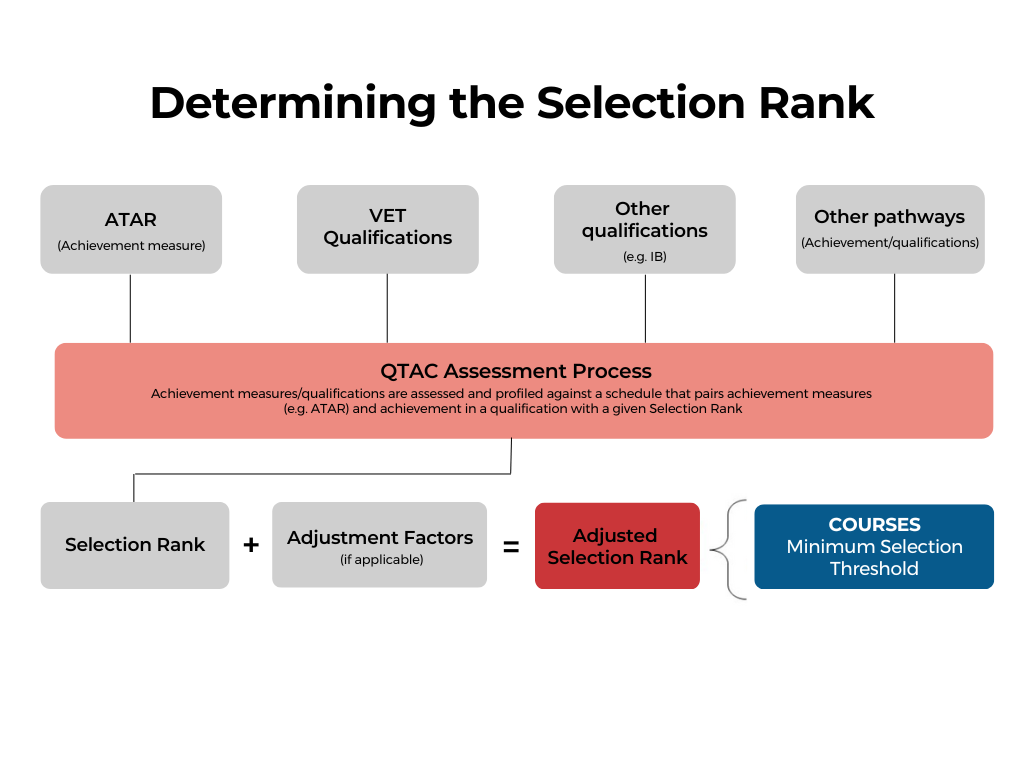Many students working hard to get into a chosen course will be aiming for that magic number – the selection rank ‘cut-off’ (or minimum selection threshold) which may make them eligible for their course.
A selection rank is the rank required for eligibility for entry into a particular course of study. The selection rank is determined by using an applicant’s ATAR, qualifications and other adjustment factors. The flowchart below summarises how selection ranks are determined.

Selection ranks and how they are used by institutions to select applicants are not simple. We asked our QTAC specialists to identify some of the most common questions they get about the selection rank processes. We’ve also included links to information on the QTAC website.
MYTH #1 The ATAR is your selection rank
The ATAR itself is not a selection rank. The ATAR is an achievement measure of how you ranked against all other year 12s in your cohort. As an achievement measure, it is profiled against a specific schedule to give a selection rank. It just so happens that the value of that selection rank is the same as the ATAR. For many school leavers the ATAR will be their only input into a selection rank if no other adjustments apply.
MYTH #2 Rank adjustments are added to your ATAR to increase your ATAR
No. Adjustments are added to the ATAR selection rank to determine the final selection rank. The ATAR itself stays the same. In the past rank adjustments were sometimes referred to as ‘bonus points’.
MYTH #3 All institutions use the same criteria to calculate your selection rank
No. Institutions have different rules for applying adjustments to a selection rank and adjustments are often course specific. Find out more about adjustments and the selection rank profile.
MYTH #4 The selection rank for a course is always the same every year
No. The published minimum selection threshold is based on the previous year’s Semester 1 intake period and varies from year to year.
The minimum selection threshold is the minimum adjusted score (rank) that was required for an offer of a place. The minimum selection threshold was previously referred to as a ‘cut-off’. Minimum selection thresholds vary from year to year, and from offer round to offer round, depending on the number and quality of applicants a course receives.
MYTH #5 If you do a VET subject you automatically get a certain selection rank
Some institutions (not all) may consider completed VET qualifications, at Certificate III level and higher, as a basis of tertiary admission. The VET qualification will be assessed as a stand-alone qualification according to a schedule and given a selection rank. Find out more about VET qualifications for tertiary entrance and individual institution schedules.
MYTH #6 Only year 12 applicants can use VET for their selection rank
No. Anyone who applies to QTAC, including non-year 12s, will have their VET qualifications assessed as part of their application in the same way as all other applicants. Institution policies will determine how the selection rank from VET qualifications are used.
FAQ – Where can I find out what selection rank is needed for a course?
Use QTAC’s Course Search to find a course. Each Course Search entry shows a selection rank profile reflecting the selection rank required in the previous year’s January offer round. Information is published for every domestic entry undergraduate course that uses the selection rank wholly or partly, in the tertiary admission process.
Contact us at QTAC for more information
Call 1300 467 822
